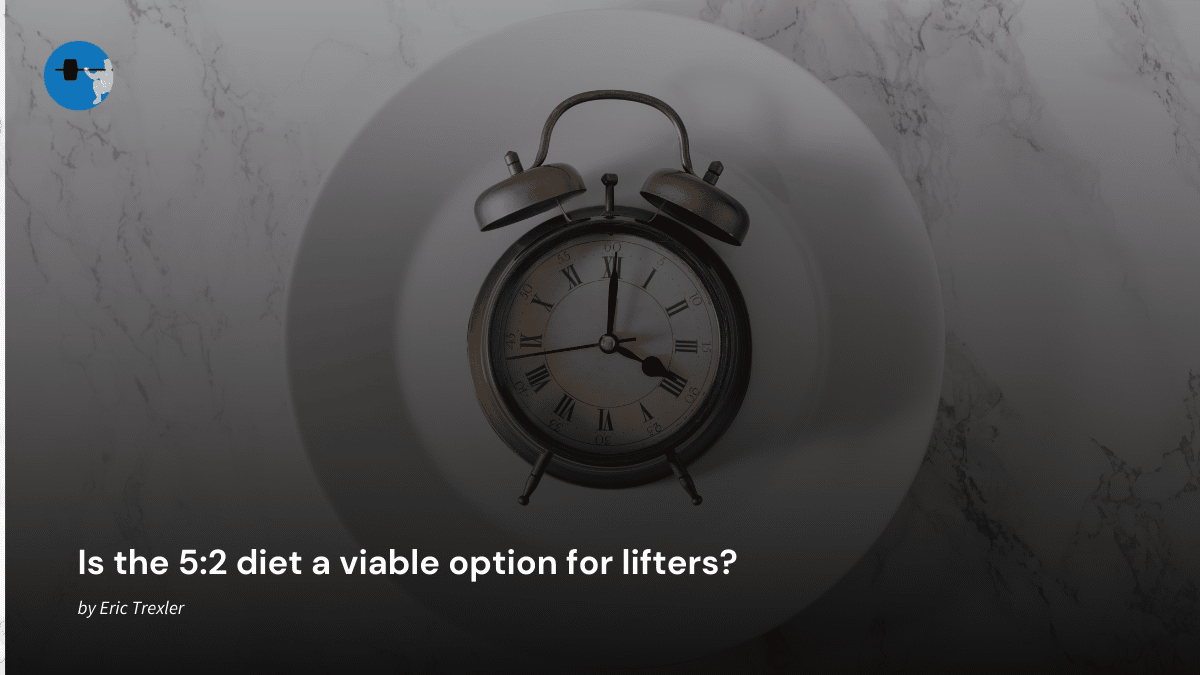“Intermittent fasting” is an umbrella term. In the evidence-based fitness world, we often think of intermittent fasting as time-restricted feeding, which involves implementing a daily fasting period (typically between 16-23 hours long), but allows for daily energy consumption within the specified feeding window. However, many other strategies can be considered forms of intermittent fasting. For example, there is alternate-day fasting, in which dieters alternate between normal eating days and complete fasting days (that is, virtually zero energy intake for the full 24-hour period). There’s also modified alternate-day fasting, which alternates between normal eating days and very, very low-calorie days (typically ≤40% of an individual’s maintenance calories, or ≤600 kcal/day). Another option is the “5:2 diet.” This consists of five normal eating days per week, along with two “fasting” days. These fasting days can be consecutive or nonconsecutive, and typically allow for ≤40% of an individual’s maintenance calories, or ≤600 kcal/day.
We’ve covered time-restricted feeding many times, but I’m not aware of any studies investigating the 5:2 diet within the context of resistance training. Until now, that is. A recent study by Keenan et al sought to compare the effects of 5:2 intermittent fasting and regular, continuous energy restriction on changes in strength and body composition over 12 weeks. This study was completed by 17 weight-stable, healthy, untrained adults between 18-45 years of age (8-9 males and 8-9 females in each group). In order to participate, males needed to have a body-fat percentage above 18%, and females needed to have a body-fat percentage above 25%, as measured via DXA. Training consisted of two supervised full-body resistance training sessions per week, in addition to one unsupervised training session that consisted of bodyweight calisthenics.
The continuous diet group consumed a daily energy deficit of around 20% (that is, they consumed 80% of their estimated energy needs), while aiming for a daily protein intake of about 1.4g/kg. The 5:2 group consumed 100% of their estimated energy needs five days per week, and implemented two modified, nonconsecutive fasting days per week (on non-training days). I call them “modified” fasting days because they allowed for some energy consumption, rather than requiring a complete absence of energy intake. On these fasting days, participants were instructed to consume only 30% of their energy needs (e.g., a 70% deficit), and to consume all of their calories between noon and 6pm. The 5:2 group was instructed to consume 1.5g/kg of protein on non-fasting days, and 1.1-1.2g/kg on fasting days. As a result, the diets were approximately isocaloric and isonitrogenous, with both groups averaging a 20% energy deficit across the week and consuming an average of about 1.4g/kg/day of protein.
In short, the performance results in this study weren’t particularly exciting or informative. Strength and strength-endurance were assessed by determining bench press and leg press 3RM values, in addition to total volume completed (load × reps) during a single set to failure with 70% of the individual’s estimated 1RM load for bench press and leg press. The performance results weren’t particularly exciting, because there were no significant interaction effects to speak of; these untrained participants generally got stronger in response to 12 weeks of training, and the males generally lifted greater loads than the females. Beyond that, the performance results were, in my opinion, bound to be fairly uninformative anyway. When untrained individuals complete 12 weeks of resistance training, their initial strength gains will be very large and driven primarily by factors related to motor learning and skill acquisition. In this context, you’re unlikely to observe a statistically significant effect of a nutrition intervention on strength outcomes, even in a very well-controlled study. In addition, participants in the presently reviewed study didn’t actually train the leg press or bench press exercises throughout the 12-week training program. This makes us even less likely to observe a statistically significant effect, given that we’re looking at residual adaptations that are carrying over to the bench press and leg press tests from entirely different training exercises. As a result, that’s just about all I’m going to say about the performance outcomes from this study.
As we move to body composition results, things start to get more interesting. You might have noticed that the beginning of this study’s title gives away the ending: “Intermittent fasting and continuous energy restriction result in similar changes in body composition.” That statement isn’t untrue, but it tells only a portion of the whole story, and from a lifter’s perspective, it tells the least informative part (in my opinion). As that title suggests, DXA results indicated that participants increased lean mass while losing weight and fat mass, with no significant differences between the groups. However, in addition to measuring whole-body lean mass via DXA, the researchers also measured changes in muscle size via ultrasound and CT (computed tomography) scans. These more direct measures suggested that the continuous energy restriction diet led to significantly larger increases in muscle surface area, and led to more favorable changes in ultrasound measurements of muscle cross-sectional area and thickness, with two of the three ultrasound outcomes reporting p-values near the statistical significance threshold (p = 0.05 and p = 0.07). A selection of body composition and muscle size outcomes are presented in Table 1.

When reviewing research, we always have to keep important limitations in mind. When it comes to hypertrophy studies, there are two glaring and fairly ubiquitous limitations that we encounter frequently: limited muscle growth can occur over a timespan of only 8-12 weeks, and most common measurement techniques for muscle hypertrophy lack precision. As a result, it would be very shortsighted to confidently conclude that two dietary approaches are “equivalent,” just because changes in whole-body lean mass, measured via DXA, were not significantly different between groups. As a side note, this would also be incorrect, as we cannot say that things are “equivalent” just because they aren’t significantly different; you can find more information about this distinction here and here.
The first implication of these limitations is that, whenever possible, we should place more confidence in more direct measures of hypertrophy than less direct measures of hypertrophy. In some of my recent work on protein sources, I’ve cautioned that blood amino acid responses are not perfect proxies for muscle protein synthesis, and that muscle protein synthesis is not a perfect proxy for changes in lean mass. We can take that one step further by acknowledging that the change in whole-body lean mass is not a perfect proxy for muscle hypertrophy. Lean mass changes derived from DXA (and other common body composition techniques) are informative, but they refer to all non-fat tissues of the body rather than muscle tissue specifically. When compared to direct measures of hypertrophy (such as changes in volume or area, as measured via ultrasound, MRI, CT scan, or muscle tissue biopsies), these whole-body measures of lean mass are less ideal because they are influenced by non-muscle lean tissues, and they are less able to provide a precise quantification of changes in muscle size. In a study like this, where the DXA-derived lean mass values suggest no significant difference, but the more direct measures (ultrasound and CT scan) lean toward a less favorable change in the 5:2 diet group, I’m inclined to place more confidence in the ultrasound and CT scan results.
It might seem that I’m placing too much confidence in these results, given that only one of the ultrasound and CT scan outcomes in Table 1 actually cleared the bar for statistical significance. That’s a defensible perspective, but there are some scenarios in which “almost significant” findings warrant some extra attention. In this case, the CT and ultrasound results all generally lean in the same direction, and we’re talking about hypertrophy measurements over a short 12-week time frame. As we recently saw in a review by Dr. Helms, it’s very possible that we only get subtle clues about unfavorable hypertrophy responses in short-term studies on intermittent fasting strategies (such as time-restricted feeding), which start to materialize into larger and more noteworthy discrepancies over longer periods of time. In addition, the 5:2 diet intervention in this study was structured in a way that defies our current understanding regarding “best practices” of total daily protein intake and protein distribution. The fasting days utilized a protein target (1.1-1.2g/kg) that is well below the standard “optimal” range of 1.6-2.2g/kg, and the meal distribution guidelines constrained the feeding window in a manner that would reduce the likelihood of getting at least three large protein doses spread throughout the day, which seems to be favorable. So, we’ve got a short study timeline, some “almost significant” results leaning in the same direction, and they’re leaning in a direction that makes perfect sense based on our current understanding of protein intake and distribution. In this type of scenario, I’m inclined to pay a little more attention to the ultrasound and CT scan results, even if there aren’t statistically significant findings across the board.
In conclusion, these findings make it hard to suggest that the 5:2 diet is an “optimal” approach for lifters. However, it’s also worth noting that this dietary strategy did not have an absolutely catastrophic impact on various indices of hypertrophy. Collectively, the data suggest that continuous energy restriction led to more favorable changes in muscle size, but the 5:2 approach might still have some utility if your top priority is fat loss, you’re comfortable with a slightly suboptimal effect on muscle mass, and it’s the energy restriction method that most effectively suits your preferences and reinforces your consistency. Weight loss can be extremely challenging, and the method that most effectively supports your consistent adherence may not necessarily be the approach that is fully optimized for skeletal muscle growth or retention. If you do find the 5:2 approach to be an attractive option, I suspect you can minimize some of the downsides by following a few simple guidelines for your fasting days: make sure they’re scheduled on non-training days, try to aim for a protein target of (at least) 1.4-1.6g/kg, and try to get at least 3 large protein feedings, distributed fairly evenly throughout a feeding window of at least 8 hours in duration. This approach still might not lead to a totally optimal situation for muscle growth (or maintenance), but it’s probably the best way to structure the 5:2 diet for lifters.
Note: This article was published in partnership with MASS Research Review. Full versions of Research Spotlight breakdowns are originally published in MASS Research Review. Subscribe to MASS to get a monthly publication with breakdowns of recent exercise and nutrition studies.




